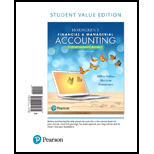
Concept explainers
1.
Closing entries: These refers to the journal entries that are recorded at the end of an each accounting period. It closes all revenue accounts earned, and all expenses account incurred during the current accounting year to the income summary account.
Periodic Inventory System: It is a system in which the inventory is updated in the accounting records on a periodic basis such as at the end of each month, quarter or year. In other words, it is an accounting method which is used to determine the amount of inventory at the end of each accounting period.
To Record: The closing entries of Company OL.
2.
T Accounts: T- accounts are prepared for all the business transactions. First, journal entries are passed and then transferred to the respective ledger accounts where they are recorded, and summarized in either side of the ‘T’ format. It is divided into two parts by a vertical line, that is, the left side and the right side. The left side of the T-account is known as the debit side, and the right side of the T-account is known as the credit side. The account name appears on the top of the T-account.
To Post: The above closing entries to their respective T-accounts of Company OL.
3.
Net income represents the revenue after the deduction of total expenses from the total revenue. Its mathematical representation is as below:
To Calculate: The net income or loss of Company OL.
Want to see the full answer?
Check out a sample textbook solution
Chapter 5 Solutions
Horngren's Financial & Managerial Accounting, The Managerial Chapters, Student Value Edition Plus MyLab Accounting with Pearson eText -- Access Card Package (6th Edition)
- What is the current price of this bond if the face value is $1,000 on these financial accounting question?arrow_forwardgeneral accountingarrow_forwardYou have successfully started and operated a company for the past 10 years. You have decided that it is time to sell your company and spend time on the beaches of Hawaii. A potential buyer is interested in your company, but he does not have the necessary capital to pay you a lump sum. Instead, he has offered $500,000 today and annuity payments for the balance. The first payment will be for $270,000 in three months. The payments will increase at 1.4% per quarter and a total of 30 quarterly payments will be made. If you require an EAR of 13%, how much are you being offered for your company? (Do not round intermediate calculations. Round the answer to 2 decimal places, e.g., 32.16.)arrow_forward
- Crane top uses the periodic inventory system. For the current month, the beginning inventory consisted of 486 units that cost $66 each. During the month, the company made two purchases: 720 units at $69 each and 355 units at $71 each. Crane also sold 1200 units during the month. Using the FIFO method, what is the amount of cost of goods sold for the month? 79,200 82,224 81,342 83,135arrow_forwardCompute the Total assets turnoverarrow_forwardI need help with this solution and accountingarrow_forward
- Fleming corporation reports the following financial dataarrow_forwardWhat is the cash paid for income taxes during the year?arrow_forwardACP Manufacturing has budgeted a total overhead cost of $850,000 and budgeted machine hours of 85,000 for the upcoming period. During the actual period, the total overhead incurred was $865,000, and actual machine hours used were 90,000. Find the applied overhead for the period and determine whether the overhead is overapplied or underapplied. Show your step-by-step solution.helparrow_forward

 AccountingAccountingISBN:9781337272094Author:WARREN, Carl S., Reeve, James M., Duchac, Jonathan E.Publisher:Cengage Learning,
AccountingAccountingISBN:9781337272094Author:WARREN, Carl S., Reeve, James M., Duchac, Jonathan E.Publisher:Cengage Learning, Accounting Information SystemsAccountingISBN:9781337619202Author:Hall, James A.Publisher:Cengage Learning,
Accounting Information SystemsAccountingISBN:9781337619202Author:Hall, James A.Publisher:Cengage Learning, Horngren's Cost Accounting: A Managerial Emphasis...AccountingISBN:9780134475585Author:Srikant M. Datar, Madhav V. RajanPublisher:PEARSON
Horngren's Cost Accounting: A Managerial Emphasis...AccountingISBN:9780134475585Author:Srikant M. Datar, Madhav V. RajanPublisher:PEARSON Intermediate AccountingAccountingISBN:9781259722660Author:J. David Spiceland, Mark W. Nelson, Wayne M ThomasPublisher:McGraw-Hill Education
Intermediate AccountingAccountingISBN:9781259722660Author:J. David Spiceland, Mark W. Nelson, Wayne M ThomasPublisher:McGraw-Hill Education Financial and Managerial AccountingAccountingISBN:9781259726705Author:John J Wild, Ken W. Shaw, Barbara Chiappetta Fundamental Accounting PrinciplesPublisher:McGraw-Hill Education
Financial and Managerial AccountingAccountingISBN:9781259726705Author:John J Wild, Ken W. Shaw, Barbara Chiappetta Fundamental Accounting PrinciplesPublisher:McGraw-Hill Education





